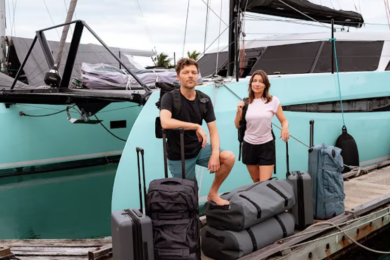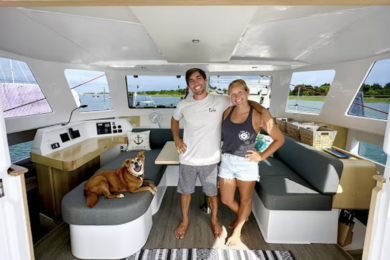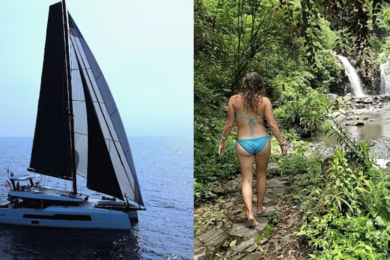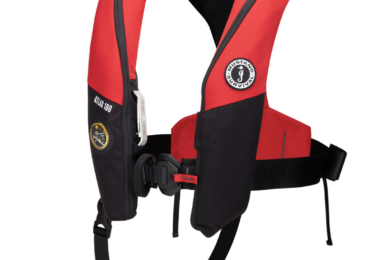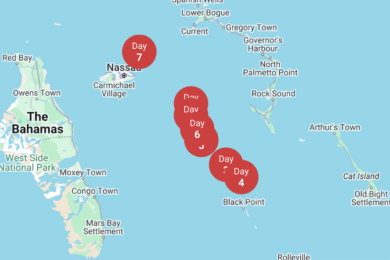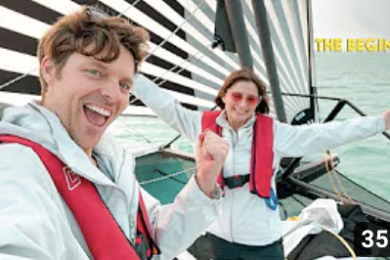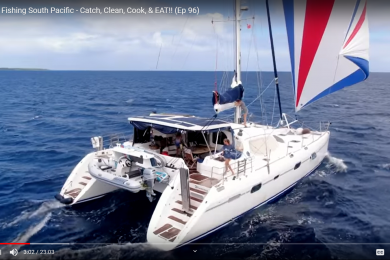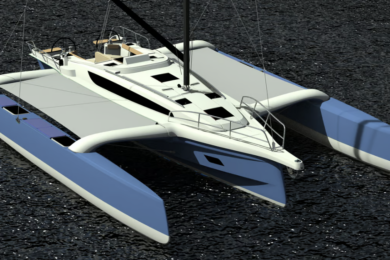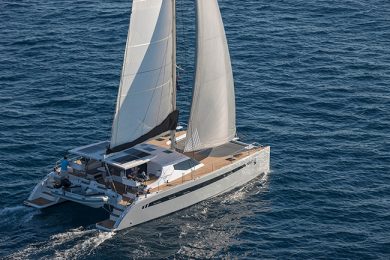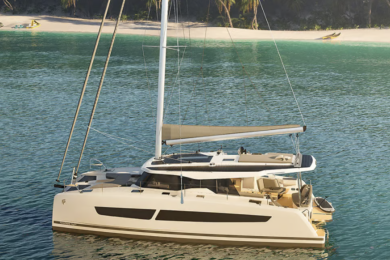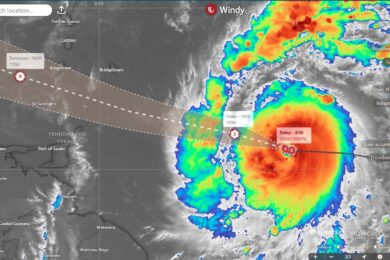
A look at the myriad material possibilities (Published Winter 2011)
A good multihull is a light, fast, exciting machine. To achieve this status, both the engineering/design and construction must be top-notch. To borrow a phrase from automotive drag racing, “fast, cheap, reliable: choose two.” With their wide beam and required light weight, stiffness and strength of the overall structure are very important. Clearly, this points the design straight to modern composite construction.
Typical fibers used in custom construction are E-glass (the most common fiberglass used), S-Glass, Kevlar (the generic name of Aramid) and carbon fiber, also called graphite fiber. Typical resins are polyester, vinylester and epoxy. With its superior bonding, strength, fatigue resistance and low water absorption, epoxy is the resin of choice for a custom boat, and the only one we will be considering from this point on.
At this stage, we need to introduce some terms: density, stiffness (called Young’s modulus, E), strength (both tension, t, and compression, c), specific stiffness, and specific strength. Density is straightforward; it is the weight (mass in SI units) of the laminate per unit volume (lbf/ft3). Stiffness is a measure of the amount of load required to stretch (or compress if in compression) the material; the units are force over area. The more load for the same stretch, the higher the stiffness. Strength is a measure of what it takes to break the laminate; the units are also force over area, the better to keep it confusing.
Beyond these basics, specific stiffness and strength need to be considered. These are particularly important to understand for multihulls. Essentially, specific stiffness and strength are the ratio of the strength or stiffness to the density. Think of it as a measure of efficiency, with the higher specific value being better. Sadly, in general, the higher the specific strength and stiffness, the higher the price tag.
The following is a quick comparison of the properties of the different fibers, obtained from composites.about.com; all fibers are unidirectional in epoxy pre-preg (the highest values likely to be seen):
SELECTING YOUR COMPOSITE
The question that arises after the technical bits is, of course, “which composite to use”? Let’s look at the big picture. What is important in a multihull? A multihull has two or three hulls connected by beams. The deflection and stresses in the beams are an exponential function of the beam length: if the beam gets a little longer, stresses and deflections go up much more. Clearly, this is an excellent application for carbon fiber, with its high specific stiffness and strength, particularly in both tension and compression. Kevlar looks good due to its lowest density, but it has very low compressive strength—no good for a beam.
Most readers will be familiar with the term “sandwich construction.” This is a form of construction where two relatively thin skins of laminate are separated by a core. Sandwich structures are used in situations where a panel is subjected to out of plane loads, when the load is perpendicular to the surface. Hulls, decks and cabin soles are perfect examples. The stiffness and strength properties of a panel are exponentially related to thickness. This is the underlying principle of sandwich construction. The lightweight core is used to keep the top and bottom skins of the sandwich separated, yet working together. The result is that the skins actually see the loads in plane, even though the load is applied perpendicular to the surface. The core sees the loads as a shear load, connecting the tension and compression loads of the skins. Therefore, with cores, the big number to be concerned with is the shear value.

Another important value is the elongation to failure. This is a measure of how far the core will essentially stretch before failing. The higher the value, the “tougher” the core. Another big plus with sandwich construction is that the framing requirements can be greatly reduced, simplifying the construction. By increasing the core thickness, the size of the panel can be increased at a relatively low weight penalty and virtually no labor penalty.
Core thickness can also be used to compensate for different fibers. A panel that might be made of carbon can be made of glass instead to save laminate cost by increasing the core thickness. However, there will be a weight penalty and extra cost. For example, a simple panel consisting of a 9 oz/yd2 carbon laminate of 1 ply at 0° and 1 ply at 90° on either side of a 3/4” 5 lb/ft3 core theoretically at 1 psi pressure load gives .076” of deflection for a 24”x48” panel. The same laminate only in E-glass requires the core to be increased to 1.25” for essentially the same deflection, .077”. These numbers are predicted from the Vectorlam software.
BUILDING THE BOAT
As interesting as the engineering is, there is still the equally important issue of actually building the boat. Here is an all too often scenario: “I have the best design, I have the best engineering, I am prepared to buy the best materials…now let’s build the boat halfway around the world in a third world yard with unskilled labor.” This is where engineering and construction meld. The engineering of the boat is based upon the boat coming out close to her estimated weight. Particularly with a multihull, excess weight increases the loads on everything and decreases performance. A skilled yard will build the boat to the plans, constantly keeping track of weight control.
A good yard will be up to date with modern composite construction. They will understand the processing requirements of the various cores, fibers and resins available. Vacuum bag construction will be a standard procedure. A good composite laminate will need very little finishing when it comes off the mold. Areas such as bilges will only need a coat of epoxy to seal the surface to minimize water absorption and make it easier to clean.
Where structure is taped into the hull, the taping laminates will be tapered out and the edges of the taping will be smooth. The actual laminate of the hull and deck, where visible—for example, under bunks and in lockers—will be smooth, with no more overlaps than required. Where structure is bonded into the hull, the joint should have a fillet rather than a sharp corner. These fillets should be consistent in radius. A good yard with skilled labor is able to create these fillets in one step, then install the reinforcing taping over the fillet. Other yards install the structure, create oversize fillets—which they then sand to shape—then install the reinforcing. That is an example of excess labor hours, even at the reduced cost per hour, which add no value to the boat.

A good yard makes every step count. Building the boat locally has many advantages that should not be underestimated. A custom boat is not a cheap endeavor, and its construction should be an enjoyable process. If you do not have to fly halfway around the world to visit the yard, you can be more involved.
Skilled local laborers are more capable of responding to any changes required during the build process, and their attention to detail pays off in reduced maintenance down the line. For example, the local yard with skilled workers remembers to coat the edges of any exposed core. The yard with unskilled labor does not coat the core, as the foreman is interested in getting the boat out the door as quickly as possible. Two years later, that exposed core is now absorbing water, causing the paint on that part to fail. The part then has to be repainted, and meanwhile, the absorbed water has added to the weight of the boat, reducing performance. And on and on.
The ramifications of the materials’ cost is not always fully appreciated. The materials for a boat cost the same wherever the boat is built, no matter what the currency. Most manufacturers of the materials used in modern composite construction produce those products in North America. Building the boat locally means that more of the money used for the construction process goes into creating value in the finished product, rather than enriching shipping lines and airlines.
From the time he was eight years old, Dave Walworth has been drawing, sailing and living boats. Along the way, he completed the design program at the Landing School, received a Masters Degree from MIT in Naval Architecture, and built custom boats for five years at Goetz Custom. After three years as the naval architect at Gold Coast Yachts, Dave formed Walworth Yacht Designs in 2000 and has been busy with both engineering and design work. Some notable designs include Three Little Birds, the first PT11 tri, Makani, a 65-foot sailing cat, and Caribbean Spirit, a unique 78-foot sailing cat with a schooner rig. Visit walworthdesigns.com for more info.


